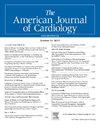选择性桡动脉入路冠状动脉造影时,身高对介入心脏病医师职业辐射暴露的影响。
IF 2.1
3区 医学
Q2 CARDIAC & CARDIOVASCULAR SYSTEMS
引用次数: 0
摘要
辐射暴露是介入心脏病专家面临的最不利的职业危害之一。操作人员的身高会影响操作人员的辐射暴露。这项单中心回顾性研究(n=534)评估了使用桡动脉入路时主要操作者在四个解剖位置的三种不同身高范围(矮、正、高)的累积辐射(CR)暴露(μSv)和标准化辐射暴露(CR/DAP)。一项针对操作者累积辐射剂量的多元线性回归分析发现,高个子操作者的胸围明显低于普通操作者的胸围本文章由计算机程序翻译,如有差异,请以英文原文为准。
The Influence of Height on Occupational Radiation Exposure of Interventional Cardiologists During Selective Coronary Angiography Using a Radial Artery Approach
Radiation exposure is one of the most adverse occupational hazards faced by interventional cardiologists. Operator height can influence operator radiation exposure. This single-center retrospective study (n = 534) assessed the cumulative radiation (CR) exposure in μSv and normalized radiation exposure (CR/DAP) using three different ranges of height (short, regular, and tall) of the primary operator at four anatomical locations when using a radial artery approach. A multivariate linear regression analyses for cumulative operator radiation dose found that tall operator height had significantly lesser values than regular operator height for the thorax (p <0.001), abdomen (p = 0.01), left eye (p <0.001), and right eye (p <0.001). Short operator height did not significantly differ from regular operator height. Multivariate linear regression analyses for normalized operator radiation dose found that tall operator height had significantly lesser values than regular operator height for the thorax (p <0.001), abdomen (p = 0.01), left eye (p <0.001), and right eye (p = 0.002). Short operator height did not significantly differ from regular operator height. In conclusion, there was an association of lower operator radiation dose in the thorax, abdomen, left eye, and right eye for tall operators as compared to regular height operators. We recommend regular height operators be exceedingly vigilant with their personal radiation protection techniques. Furthermore, these same protection techniques should be considered with patients that have a higher likelihood of generating greater dose-area-products.
求助全文
通过发布文献求助,成功后即可免费获取论文全文。
去求助
来源期刊

American Journal of Cardiology
医学-心血管系统
CiteScore
4.00
自引率
3.60%
发文量
698
审稿时长
33 days
期刊介绍:
Published 24 times a year, The American Journal of Cardiology® is an independent journal designed for cardiovascular disease specialists and internists with a subspecialty in cardiology throughout the world. AJC is an independent, scientific, peer-reviewed journal of original articles that focus on the practical, clinical approach to the diagnosis and treatment of cardiovascular disease. AJC has one of the fastest acceptance to publication times in Cardiology. Features report on systemic hypertension, methodology, drugs, pacing, arrhythmia, preventive cardiology, congestive heart failure, valvular heart disease, congenital heart disease, and cardiomyopathy. Also included are editorials, readers'' comments, and symposia.
 求助内容:
求助内容: 应助结果提醒方式:
应助结果提醒方式:


